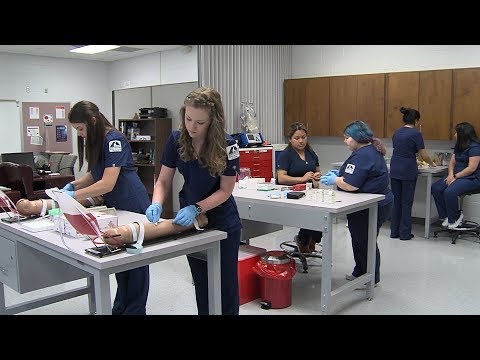How Long is Schooling for a Medical Assistant?
Contents [show]
Schooling to become a medical assistant varies in length. Some programs may take as little as a few months to complete while others may take up to two years.
Checkout this video:
How long is schooling for a medical assistant?
The length of schooling for a medical assistant varies depending on the program. Some schools offer certificate programs that can be completed in as little as six months, while others offer two-year associate’s degree programs. There are also four-year bachelor’s degree programs in medical assisting, although these are not as common. Most Medical assistants complete a one- to two-year program and earn a certificate or diploma.
The medical assistant career outlook
Medical Assistants are in high demand and the career outlook for this profession is very positive. According to the Bureau of Labor Statistics, employment of medical assistants is expected to grow by 29 percent from 2016 to 2026 — much faster than the average for all occupations. This growth is largely due to an increase in the number of aging baby boomers and their need for medical services.
If you’re considering a career as a medical assistant, you’re probably wondering how long it will take to complete your schooling. The good news is that most medical assistant programs can be completed in just two years or less. And, if you choose to pursue an associate’s degree, you may be able to complete your program in as little as 18 months.
The duties of a medical assistant
A medical assistant is a multi-skilled professional who comprises both clinical and administrative duties in a medical facility under the supervision of a licensed physician. As a medical assistant, your duties will vary depending on the size and type of facility you work in, but may include tasks such as taking medical histories and vital signs, preparing patients for examination, assisting the physician during examination and procedures, scheduling appointments, handling correspondence, billing and coding insurance forms, and handling office finances. Depending on your employer’s needs, you may also be responsible for laboratory work, dispensing medications, or providing patient education.
Most medical assistants have postsecondary education such as a certificate or diploma from an accredited medical assisting program; however, some states have certification requirements for certain tasks such as dispensing medications or performing laboratory procedures. Medical assistants with formal education typically complete a one-year program that leads to a certificate or diploma, although some earn associate degrees in medical assisting. In addition to coursework in human anatomy and physiology, Medical Terminology and healthcare ethics, most programs include an externship where students gain real-world experience in a healthcare setting.
The skills needed to be a medical assistant
Medical assistants perform many tasks to support the work of physicians and other health professionals. They are sometimes known as clinical assistants or medical office assistants.
Most medical assistants have postsecondary education such as a certificate or diploma from a medical assisting program. Some states have certification programs for medical assistants. Programs typically last from 3 to 18 months and lead to a certificate or diploma. Some community colleges offer 1-year programs that lead to an associate degree.
In addition to completing an accredited educational program, most states require medical assistants to pass a certification exam. The Certifying Board of the American Association of Medical Assistants offers the Certified Medical Assistant (CMA) credential. To maintain the credential, medical assistants must complete continuing education every few years. Some employers prefer or require their medical assistants to be certified.
The job market for medical assistants
The job market for medical assistants is expected to grow much faster than the average for all occupations between 2018 and 2028, according to the U.S. Bureau of Labor Statistics (BLS). The median annual wage for medical assistants was $33, 610 in 2018. Employment of medical assistants is projected to grow by 23 percent from 2018 to 2028, much faster than the average for all occupations.
A medical assistant career typically requires a high school diploma or equivalent, although postsecondary education is beneficial. Some states require certification or licensure for certain tasks, such as taking X-rays or administering medications. However, many employers prefer to hire candidates who have completed a postsecondary education program in medical assisting. These programs typically last about 1 year and lead to a certificate or diploma. Some programs might lead to an associate degree in medical assisting. A few schools offer bachelor’s degree programs in this field, but they are rarer and typically only last 4 years.
The salary of a medical assistant
The salary of a medical assistant can vary depending on their experience, education, and location. The average salary for a medical assistant is $15 per hour, or $31,200 per year. However, those who have more experience and are located in areas with a higher cost of living can expect to earn more.
The benefits of being a medical assistant
Medical assistants are in high demand! They are a vital part of the healthcare team, working alongside doctors and nurses to provide patient care. If you’re thinking about a career in healthcare, becoming a medical assistant is a great option. But how long is schooling for a medical assistant?
Medical assistants typically complete a one-year certificate or diploma program, which can be found at community colleges, technical schools, and vocational schools. Some programs may take longer to complete, but most will have you ready to start your career in just a year.
And the benefits of becoming a medical assistant don’t stop there! Medical assistants can earn competitive salaries and often have access to great benefits packages. They also enjoy job security, as the demand for medical assistants is expected to grow much faster than the average for all occupations through 2026.
So if you’re looking for a rewarding career in healthcare, becoming a medical assistant is a great option. And with most programs taking just one year to complete, you can be on your way to an exciting and fulfilling career in no time!
The drawbacks of being a medical assistant
Becoming a medical assistant is a great way to start a career in the medical field. Medical assistants perform a variety of administrative and clinical tasks to support the work of physicians and other health professionals. They are often responsible for scheduling appointments, maintaining medical records billing and coding insurance forms, and providing patient education.
Although medical assisting is a rewarding career, there are a few drawbacks that you should be aware of before you decide to enter the field. First, the job outlook for medical assistants is not as strong as it is for other health care occupations. The Bureau of Labor Statistics projects that employment of medical assistants will grow by only 29 percent between 2016 and 2026, much slower than the average for all occupations.
Second, medical assistants are often underpaid for the important work they do. The median annual salary for medical assistants was $31,540 in 2016, according to the Bureau of Labor Statistics. That’s only about $15 an hour! And many medical assistants are paid even less than that.
Third, working as a medical assistant can be stressful. You will be working with sick people all day long and will often see firsthand the devastating effects of disease and injury. You may also have to deal with angry or upset patients or their family members.
fourth , you will need to be comfortable with blood and other bodily fluids . If you faint at the sight of blood or become queasy when dealing with injuries , then becoming a medical assistant is probably not the right choice for you .
Finally , keep in mind that becoming a medical assistant requires formal training . Most employers prefer to hire candidates who have completed an accredited program , which can take anywhere from nine months to two years . So if you’re looking for a new career but don’t want to go back to school for several years , then becoming a medical assistant might not be the best option for you .
How to become a medical assistant
Medical assistants are uniquely qualified to perform both clinical and administrative tasks in a medical office setting. They are an integral part of the health care team, working alongside physicians and other health care professionals to provide quality patient care.
Becoming a medical assistant is a great way to get started in the medical field. Medical assisting programs can be completed in as little as 10 months, making it a relatively short and affordable path to a new career.
While all medical assisting programs must include coursework in anatomy and physiology, medical terminology, medical office procedures, and pharmacology, there is some variation in the curriculum from one program to the next. Some programs may also offer externship opportunities that allow students to gain hands-on experience in a real-world medical office setting.
After completing a medical assisting program, graduates must take a certification exam offered by one of several professional organizations, such as the National Healthcare Association or the American Association of Medical Assistants. Once they have passed the exam, they will be certified as Medical Assistants (CMAs) or Registered Medical Assistants (RMAs). Certification is not required in all states, but it may be required by some employers.
FAQs about medical assistants
The schooling for a medical assistant typically lasts around two years. However, there are many different types of programs available, so the length of time it takes to become a medical assistant can vary. Some programs may take as little as a few months to complete, while others may take up to four years. There is also the option to become certified through on-the-job training, which can take anywhere from a few weeks to several months.







